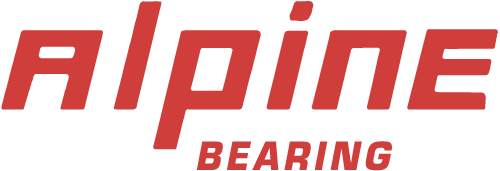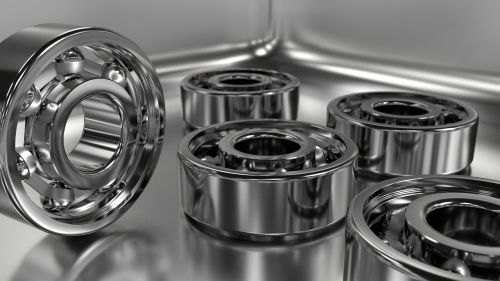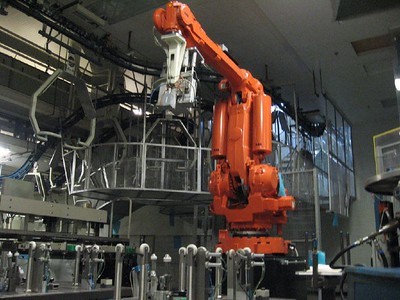
We’ve started a feature on the Alpine Bearing site. We call it Bearings 101 and in it, we’ll post technical articles about, you guessed it, bearings. Some will be basic, others, more complex.
We hope you learn something you didn’t know or can use this column as a resource. Think of us when describing a component or application to a coworker or client. Yes, we know there’s more to bearings than knowing the terminology, but every little bit helps.
Bearing Glossary (in case you forgot)
Angular contact bearings
Angular contact bearings have inner and outer ring races and can bear combined (radial and axial) loads simultaneously.
Ball bearings
Ball bearings are components with two round, channeled races containing steel balls. The balls roll in the groove to distribute loads and reduce friction between two surfaces.
Ball separators
Ball separators remove bearings, gears and pulleys for replacement, lubrication, or repair.
Bearing cages
Bearing cages keep the balls in the races symmetrical and correctly spaced, holding the bearings together. We can also call them ball bearing retainers or ball separators.
Bearing housings
Bearing housings are modular assemblies which make it easy to install bearings and shafts, while protecting bearings, extending their operating life, and simplifying maintenance.
Brinelling
Brinelling is a permanent indentation caused by excessive loads, repeated impacts, and excessive force.
Bore
A bearing’s bore is the diameter of its inner race.
Burring
Burring occurs during machining when sharp edges or burrs appear. Use a deburring tool to smooth edges.
Bushings
Bushings are thin tubes or sleeves that reduce friction and facilitate motion by sliding between two surfaces, not rolling, like a bearing.
Chamfer
A chamfer is a cut, similar to a bevel, where two surfaces meet at a sharp angle. Chamfering eases assembly and reduces the possibility of injuries to machinists.
Deburring
Deburring is the process of removing burrs (raised edges or small pieces of material) that remain attached to an item after machining. Use a deburring tool to remove them and smooth the area.
Dynamic load rating
A bearing’s dynamic load rating is the measurement of the load that determines the travel distance or number of revolutions without fatigue.
Fatigue
Fatigue is the failure, separation of materials, or cracks in the balls or races caused by wear.
Friction
Friction is the resistance that one surface or object encounters when moving over another. Bearings reduce friction.
Galling
Galling is a form of wear caused by a combination of friction and adhesion between sliding surfaces.
Lubrication
Lubrication is essential for the performance and life of roller bearings. The lubricant separates moving parts to minimize friction and prevent wear. Some lubricants provide load-bearing protective film and prevent overheating of the bearing while providing protection from corrosion, moisture, and contaminants.
Machining
Machining involves milling or turning an object to finish or hone it.
Milling
Milling is a process in which an object stays still and the tools, which cut or shape metal, rotate.
Races
Races are the grooved rings where bearing balls rest. Bearings generally have inner and outer races.
Radial ball bearings
Radial ball bearings support radial and axial loads.
Spalling
Spalling is the process when bearings spall or shed flakes of material because of impact, corrosion, or rolling pressure.
Spindle bearings
Spindle bearings are single-row angular contact ball bearings that can withstand both radial and (in one direction) axial loads.
Static load rating
A bearing’s static load rating is the ratio between the basic static load rating and the maximum combined static load applied to the bearing, dependent on the types of applications and the operating conditions.
Swarf
Swarf are metal chips or filings that fall or fly off during machining.
Tribology
Tribology is the study of friction, wear, lubrication, and bearing design.
Turning
Turning is a process in which an object rotates and the tools acting on it are stationary. We associate turning with woodworking and lathes.
Vernier caliper
A Vernier caliper is a tool to measure bearings and bearing components. The caliper measures the inner diameter (ID), outside diameter (OD), and the width (W). We describe the dimensions as ID x OD x W.
Wear
Wear is damage, erosion, or destruction by friction or use.
I’m sure there are more terms we can include in future lists. Please let us know what we can add to make our glossary more helpful.
Want to learn more? Check out our article on the differences between bearings and bushings.
Photo credit: Schaeffler






